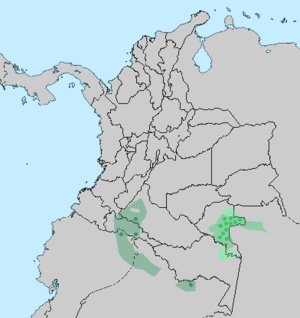Tucano people
The Tucano people (sometimes spelt Tukano) are a group of indigenous South Americans living in the northwestern Amazon, along the Vaupés River and the surrounding area. They are present in both Colombia and Brazil, although most live on the Colombian side of the border. They are usually described as being made up of many separate tribes, although the appellation is somewhat problematic due to the complex social and linguistic structure of the region.
Culture
The Tucano are a multilingual people because men must marry outside their language group; that is, no man may have a wife who speaks his language, for that kind of marriage relationship is not permitted and would be viewed as a kind of incest. Men choose the women they marry from various neighboring tribes who speak other languages. Furthermore, on marriage, women move into the men's households or longhouses. Consequently, in any village several languages are used: the language of the men; the various languages spoken by women who originate from different neighboring tribes; and a widespread regional 'trade' language. Children are born into this multilingual environment: the child's father speaks one language (considered the Tucano language), the child's mother another, and other women with whom the child has daily contact perhaps still others. However, everyone in the community is interested in language learning so most people can speak most of the languages. Multilingualism is taken for granted, and moving from one language to another in the course of a single conversation is very common. In fact, multilingualism is so usual that the Tucano are hardly conscious that they do speak different languages as they shift easily from one to another. They cannot readily tell an outsider how many languages they speak, and must be suitably prompted to enumerate which languages they speak and to describe how well they speak each one.[1]
Divisions

As mentioned above, the Tucano practice linguistic exogamy. Members of a linguistic descent group marry outside their own linguistic descent group. As a result, it is normal for Tucano people to speak two, three or more Tucanoan languages, and any Tucano household (longhouse) is likely to be host to numerous languages. The descent groups (sometimes referred to as tribes) all have their accompanying language, some of the most well known are listed below.
- Bara Tukano
- Barasana
- Cubeo (the Cubeo do not practice exogamy)
- Desana
- Macuna
- Wanano
- Tucano (or Tucano Proper)
Subsistence
The Tucano are swidden horticulturalists, growing manioc and other staples in forest clearings. They also hunt, trap, fish and forage wild plants and animals.
Further reading
- C hernela, Janet M. The Wanano Indians of the Brazilian Amazon: A Sense of Space (1996). ISBN 0292711867.
- Jackson, Jean E. The Fish People - Linguistic Exogamy and Tukanoan Identity in Northwest Amazonia (1983). ISBN 0-521-27822-8.
- Reichel-Dolmatoff, Gerardo. Rainforest Shamans: Essays on the Tukano Indians of the Northwest Amazon. ISBN 0-9527302-4-3.
Cultures
- ↑ Wardhaugh, Ronald (2009). An Introduction to Sociolinguistics. John Wiley and Sons. p. 94. ISBN 978-1-4051-8668-1.
External links
| Wikimedia Commons has media related to Tucano people. |